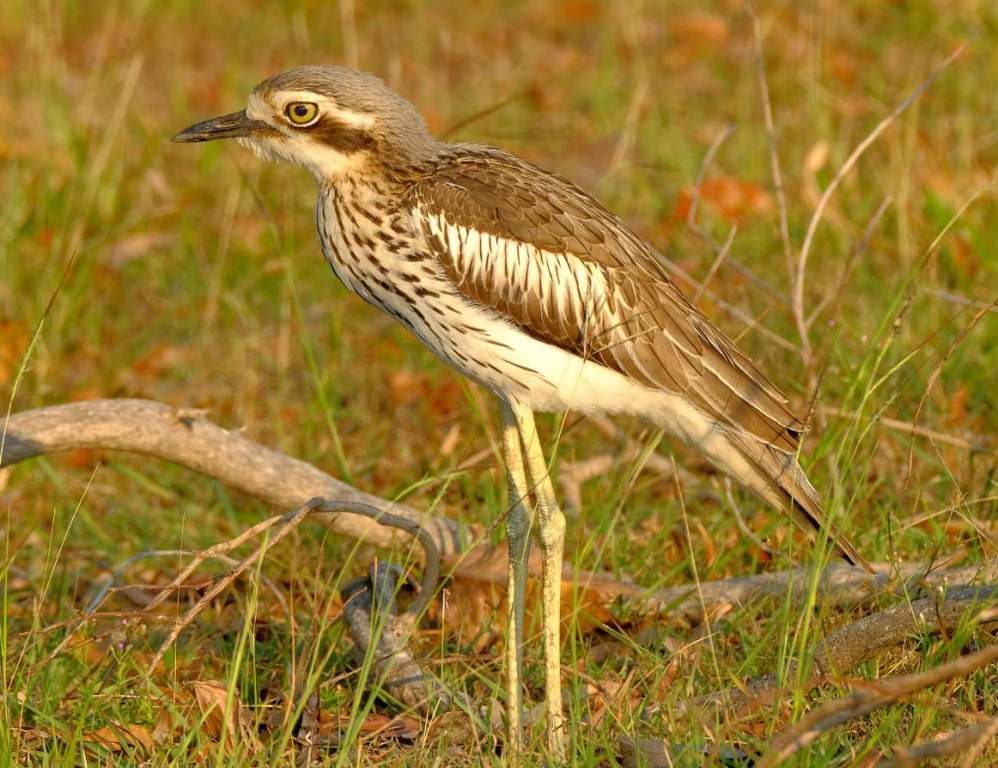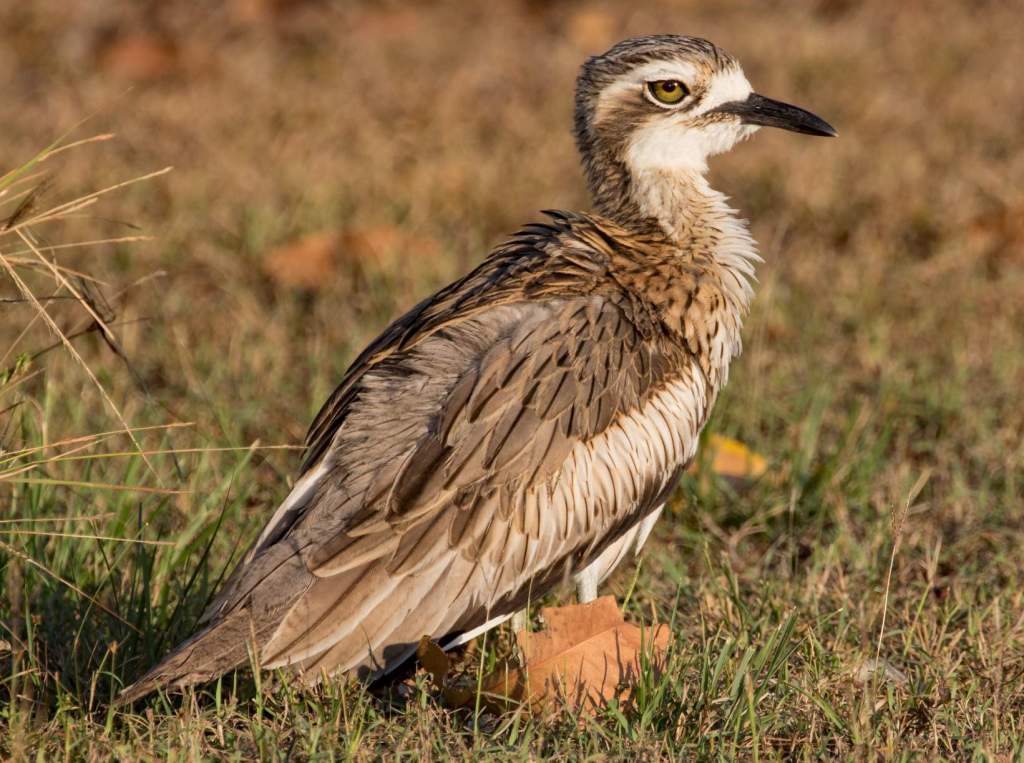Family: The bush thick-knee (Burhinus grallarius, previously known as Burhinus magnirostris) belongs to the family Burhinidae.
Habitat: During the day, they roost on broken ground that blends well with their plumage in open-grassed woodlands and sparsely treed rangelands. At rest, they squat down on their feet, with their heads out and their legs stretched forward, under their bodies. If disturbed, they tend to crouch or stalk stealthily away and then ‘freeze’, rather than fly.
Their appearance at dusk is accompanied by a multitude of loose groups ranging from ten to twenty birds. Oftentimes, they travel 20 kilometers or more to foraging grounds when not breeding. Flying on leisurely beating wings, they take off with fluttering wings and land over long distances.
While they do wander throughout the year, they are sedentary birds. Due to disturbances and predation, they have become very rare in southern pastoral areas, and they only feed at night. In the daytime, it relies on the camouflage of its plumage to evade detection; in the evening, it adopts a rigid posture to avoid detection.
They typically remain inactive during the day, hiding among tall grass or under shrubs and trees, relying on their cryptic plumage for protection from predators. Motionless and often in strange postures, they freeze when disturbed. In order to escape disturbances, they crouch and walk stealthily into vegetation, only trying to fly if vigorously pursued.

Identification: Both sexes are similar; however, the male bird is slightly larger. The upper parts are mid-grey-brown, streaked lightly to heavily black, and washed variously russet in the northern population. There is a buffy white forehead, running back in the white eyebrow, and a dusky stripe running down the side of the neck and through the eyes. Outer flight feathers are dusky, with an off-white band through the mid-vanes.
Additionally, the shoulders are patterned with a dusky grey color. The upper coverts are often washed russet and whitish, surrounded by black streaks. The tail is barred black and white on the outer feathers. The throat is plain white. The breast, belly, and flanks are white to buff, heavily streaked black, and most strongly on the breast. The undertail is white to cinnamon. The eyes are yellow. The bill is black.
The legs and feet are olive-brown. The claws are black. The immature bird is pale and light-marked. The downy young are sandy, stippled salt and pepper with black dorsal stripes, one splitting on the center of the hind crown. The other goes through each eye down the sides of the neck, running in parallel down back to the rump, another from the tail up either side of the body to the wings, and a last short, thick pair above each eye on either side of the neck.
Vocalization: The eerie screams of Bush Thick-knees at night are often the only indication that they are nearby. The common call is a loud, mournful, high-pitched, wailing wee-loo or wer-loo, which lasts about two seconds. It occurs repeatedly during the breeding season. In defense, a harsh wheeze is heard.
Diet: Puttingtering along on spindly legs, hunch-shouldered, they turn over litter and pick up insects with their bills as they feed on the ground or by wading. When they are in deeper water, they upend. Mostly gleaned or probed from soft soil or rotting wood, this bird hunts small grassland animals; frogs, spiders, insects, molluscs, crustaceans, snakes, lizards, and small mammals are among the creatures eaten; seeds and tubers are also eaten, particularly during droughts.

Nest and Breed: Nesting and breeding take place between July and January. A single brood is usually present. They nest in scrapes or small clearings on bare ground, often near trees or bushes. In the course of breeding, the groups disperse, and pairs of birds return to their traditional territories. During the night, they advertise these by singing and repeating their wailing at intervals, which can end in a hysterical jumble of sounds.
Males leading females in a follow-the-leader chase playfully strut and face intruders with drooping wings and raised tails while courting females. A pair of brood patches on the parents’ bodies brood the eggs laid at two-day intervals on the ground that match their color. It takes only a few hours for the young to hatch and walk. When danger threatens, their parents will carry them off under their wings by dropping food in front of them.
Eggs: There are two eggs laid by Bush Thick-knee, which are light stone to buff, spotted and blotched with brown, oblong-oval, and about 59 x 39 millimeters in size. There is an incubation period of 28–30 days for both sexes. It takes about 48–50 days for the young bird to reach full size.
Distribution: In Australia and offshore islands, it is found mostly in open wooded rangelands, along forest edges, and along watercourses, avoiding deserts and heavy forest. It is accidental in Tasmania. When flocks of hundreds once populated southern settlements, they are now rare. Southern New Guinea is also home to this species.
Predators: When the fox has already established itself, cats may not pose a threat to it. In addition to water poisoning and inadvertent capture in traps, the European rabbit poses a threat to this species.
Other Names: It is also known as Bush Stone Curlew, Southern Sterne Curlew, and Weeloo Willaroo.
Size: Bush thick-knees measure 510–580 mm long.
Flight: The long, broad wings of these birds enable them to fly rapidly and without clumsiness during daylight hours.
Migration: Despite the fact that they are not migrating, they may relocate to a new site in their local area depending on weather conditions.
Races: There are no races.
Related Read: Beach thick-knee (Esacus magnirostris)







